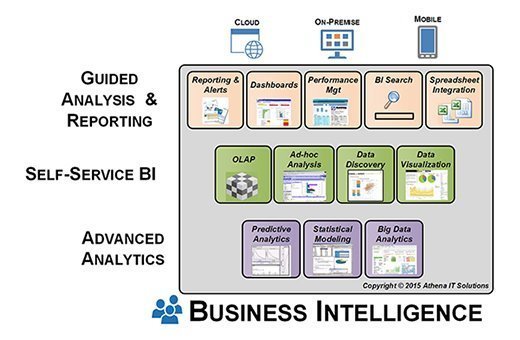Get the most out of your data, reap the benefits of BI tools
The business intelligence software market is large, vibrant and evolving. Learn the ins and outs to make sense of the options and experience the business benefits of BI tools.
Enterprises are awash in data about their customers, prospects, internal business processes, suppliers, partners and competitors. Often, they can't leverage this flood of data and convert it into actionable information to grow revenue, increase profitability and efficiently operate the business.
Business intelligence (BI) tools are what enable business people to transform data into information that will help their business.
Although BI tools have been around for decades, and many consider the industry mature, the BI market is vibrant, constantly innovating and evolving to meet the ever-expanding needs of businesses of all sizes and industries. Over the years, many BI tool styles have emerged to match the varied ways that business people need to analyze data. An understanding of these categories and styles is vital in order to meet an enterprise's analytical needs and reap the benefits of BI tools.
Types of BI analytics tools
BI analytics tools fall into three broad categories, and each supports various BI styles and capabilities.
Guided analysis and reporting. This category includes the traditional BI styles that business people have been using for years to perform recurring analysis of specific data. Examples include a vice president examining the sales pipeline, a marketing manager comparing marketing campaign performance or a chief financial officer analyzing an enterprise's financial key performance indicators.
Years ago, this category was limited to predefined, static reports, but now, business users can select, filter, compare, visualize and analyze data using many types of tool. The underlying assumption of this BI tool category is that the data set and the metrics are predefined, but the analysis varies based on the consumer's immediate information needs.
The IT group or BI team creates most of the BI applications in the guided analysis and reporting category for end users. However, business analysts also produce business intelligence software using the Self-service BI tools discussed in the following section.
Regardless of who creates the BI software, IT is responsible for the underlying data and managing the BI applications used on a recurring basis.
The BI tool styles in this category include:
- Reports
- Dashboards and scorecards
- Corporate performance management
- Spreadsheet integration
- BI search
Self-service BI and analysis. This category includes BI tools for ad hoc data analysis. This is either a one-time analysis or the formulation of a recurring analysis that users share.
Users have dual roles as information consumers and analytics producers when they share or publish a BI application created with a self-service BI tool. Users typically have the word analyst in their title -- e.g., business, financial or human resources analyst. Management staff may also use these tools when doing business analyst -- or analytical guru -- work for their managers or peers, even if their titles don't imply that.
Whereas guided discovery tools operate with a preset collection of data and metrics, self-service BI tools enable business users to add data and define new metrics when performing analysis without IT intervention.
However, there are some considerations to the no IT involvement needed hype pitched by some BI vendors. First, IT manages data source access based on need, security and privacy rights, so business users performing analyses must obtain the proper privileges to add data sources.
Second, the data sources must be consumable by the BI tool. Although business intelligence software can easily access most data sources, specific sources may prohibit access.
Third, the data source must be understandable by the business user, which often requires business people working with IT to get an explanation of the data schema and definitions the business people need to analyze.
Finally, no matter how easy the business people perceive the BI tool to be, IT must train and support the business in its effective use, both to improve business users' productivity and to increase the return on investment of these tools.
The BI tool styles in this category include:
- Ad hoc reporting and analysis
- Online analytical processing -- also referred to as OLAP cubes
- Data discovery
- Data visualization
Advanced BI and analytics encompasses the tools data scientists use to create predictive and prescriptive analytical models. This includes predictive analytics, statistical modeling, data mining and big data analytics software. Here, data scientists tend to spend a great deal of time ingesting, integrating and cleansing data.
This category is outside the scope of this article, but it is mentioned here in order to provide the entire spectrum of BI tool styles.
Here's a look at other BI tool categories and styles:

How to buy BI analytics tools
Each of the BI styles discussed here originated as stand-alone, specialized BI tools sold by emerging BI vendors. As enterprises experienced the benefits of BI tools and recognized their value, the following occurred:
- the emerging BI vendors with new BI styles grew;
- established BI vendors combined the latest BI styles with other BI styles in products; and
- larger BI vendors acquired the emerging vendors and incorporated their products into BI suites.
A key buying question an enterprise must ask is: Is it better to buy a BI suite from one BI vendor or to purchase separate products from multiple vendors? The answer: it depends.
Although other articles in this series deal with this question in depth, consider some key concepts. First, buy what's needed and don't just acquire the BI product with the most features. The enterprise may not need all that's offered. Business need and best fit should guide the selection process for the maximum benefit of BI tools.
Second, an enterprise needs to examine the costs and skills necessary to develop and manage BI applications, not just the purchase or subscription cost. Sometimes, BI suites are more cost- and resource-effective than stand-alone BI tools. However, other times, they're much more complex, resulting in higher costs, longer development lead times and the need for a greater pool of skills.
Who buys BI analytics tools?
BI and analytics tools investment and use offer long-term growth, regardless of the economic cycle. It has accelerated in recent years as enterprises have learned the benefits of BI tools, and they are now craving real-time data to not just grow and improve, but also to manage their businesses on a daily basis.
Historically, BI has been the domain of large enterprises due to the complexity, costs and skills required -- but during the past several years, those factors have changed dramatically, resulting in small and medium-sized businesses (SMBs) becoming significant BI buyers.
Many enterprises, regardless of size, initially leverage the reporting capabilities offered by their business application vendors -- such as SAP, Oracle, Microsoft, Infor and Epicor -- and use spreadsheets to fill in the gaps, especially when their focus is on tactical operational reporting. But this approach often results in data silos, limiting the ability of an enterprise to utilize the effects of its BI efforts and experience the benefits of BI tools to grow revenue and operate more effectively.
In addition, this approach wastes people's time comparing and reconciling data from these silos -- time that could be better spent running the business. When the limitations and costs of this approach become apparent, the enterprise can institute BI technology that's independent of their operational applications.
In the early days, only industries with the most significant need for data used BI. Today, enterprises in all industries have information-intensive processes that require the benefits of BI tools. The scale of the information enterprise's need to analyze varies by industry and company size, and it can impact which specific BI tools companies should consider. However, that shouldn't impact the particular BI categories and styles needed.
Top BI Vendors
The BI vendor landscape is overwhelming at first glance, as there are currently more than 100 vendors. In addition, the BI market is rife with merger and acquisition activity, so even people in the industry are sometimes confused as to who owns what.
BI vendors can be split into three groups.
- Tech titans. The market leaders in sales are IBM, SAP and Oracle, and they dominate many other technology markets. These companies secured their top positions by acquiring the market leaders about eight years ago -- Cognos, Business Objects and
- Established BI specialists. Several companies, including MicroStrategy, SAS and Information Builders, have been selling BI tools for many years and have an extensive number of users.
- Emerging BI players. These vendors offer the latest wave of BI innovation, such as data discovery, data visualization and cloud BI. Tableau, Qlik, Tibco, Logi Analytics and Birst are some of the vendors breaking out of the pack.
Although many consider Microsoft a tech titan in BI software, the company previously wasn't a recognized leader; however, in the past few years, it has emerged as a significant player, particularly in the SMB market, which is now embracing the benefits of BI tools.
Deploying BI analytics tools
When deploying BI, users must ask two questions:
- How will business people access the BI software -- on the front end?
- Where will the BI application itself operate -- on the back end?
Although there are some BI and analytics tools that exclusively use desktop client applications, almost all offer a browser-based client interface that works across all the major web browsers. BI vendors were slow to implement native-based mobile interfaces and instead relied on tablet and smartphone browsers; however, with the expanded use of mobile devices for business, that's changing.
Although most users deploy BI application servers on premises in an enterprise's data center, companies are deploying more applications on private clouds hosted by companies such as Amazon, IBM and Rackspace. When the BI client interface is browser-based, companies can make the decision to deploy the BI tool on premises or in the cloud based on their data center strategy rather than by the limitations of the BI tool.
There are emerging BI players that exclusively provide cloud-based BI deployments, often in a multi-tenant SaaS environment, with the cloud BI vendor ensuring security and privacy.
With a better understanding of the different tool categories, the vendor landscape and how BI analytics tools are deployed, the next step is to determine how your company can best utilize the benefits of BI tools. First, the enterprise must identify its needs and take a closer look at some typical use cases for which these tools are optimized.







